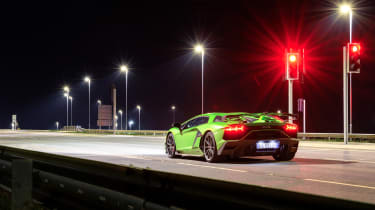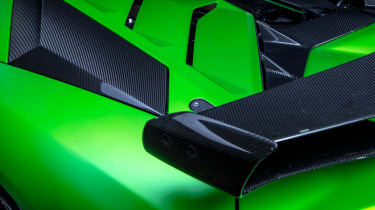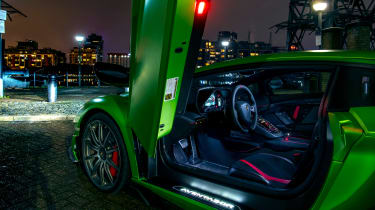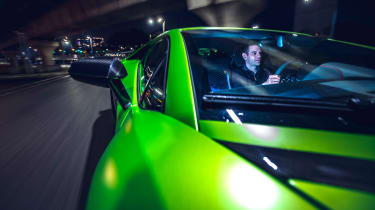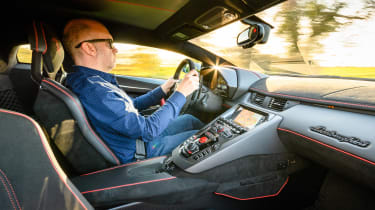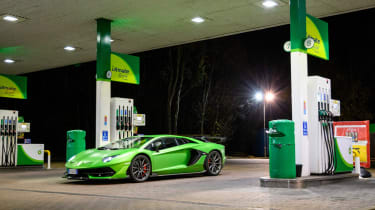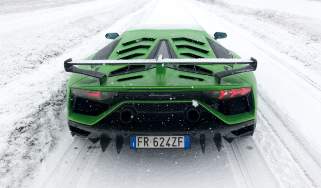Lamborghini Aventador SVJ (2018 - 2022) review – old-school in the best possible way
Despite intimidating looks, Sant'Agata's Aventador SVJ offers one of the most exploitable experiences yet
Supercapacitors, electric motors, 2000bhp and 0-100mph in 3.2sec are figures you can’t apply to the Lamborghini Aventador SVJ. So fast is the upper-crust of supercar design moving that today, the innovations introduced on the SVJ back in 2018 don’t just pale into insignificance – they almost seem old-hat.
But like all good supercars there’s more to the SVJ than just facts and figures, and where it might exist in a vacuum of four-figure horsepower rivals, when you’re locked into its bucket seat, looking out through a true pillarbox windscreen having just pulled down the scissor door, we challenge you to feel the excitement Lambo’s Aventador always instills from the moment its V12 whirrs into life.
> Lamborghini Revuelto review – the ultimate modern supercar
The SVJ has some fascinating engineering solutions contained within its brazenly jagged form. But even so, the heart of any Lamborghini has to be its engine and you’re unlikely to be disappointed by what lurks beneath the SVJ’s complex engine lid.
Engine, gearbox and technical highlights
The 6.5-litre motor has received another round of modifications aimed at squeezing not only more power from it, but also improving torque lower down the rev range and reducing the inertia of its internals. To that end, the V12 features titanium valves for the first time, teamed with a redesigned cylinder head, intake manifold and exhaust, the latter shorter in length and exiting higher at the rear, plus a lighter flywheel.
More reviews
Long term tests
Reviews
The stats say the SVJ makes 20bhp and 22lb ft more than the old SV, with 760bhp at 8500rpm (200rpm short of the limiter) and 531lb ft of torque at 6750rpm. While that peak torque figure is over 1000rpm higher than before, Lamborghini’s own graph suggests a healthy extra surge at both 4500 - 6500rpm over the old machine.
As you’d expect, the SVJ retains the long-serving automated single clutch gearbox, albeit with calibration changes. The 0-62mph figure is unchanged over the old SV (at 2.8sec), while 0-124mph takes 8.6sec and the top speed is ‘over 217mph’.
Performance, ride and handling
The core of the SVJ’s performance is the integration of its various systems under one umbrella (LDVA 2.0). Headlining here is ALA 2.0, a further evolved version of the active aerodynamics system first seen on the Huracan Performante. In simplistic terms, ALA features two slots in the nose of the car, with a further intake down the spine above the engine lid. With all these intakes closed the extended front splitter and large rear wing work as normal, increasing downforce by 40% compared to the old SV.
However, when the car is accelerating on a straight the front flaps open, preventing most of the air from going up and over the cockpit. This reduces the pressure on the splitter, forces air under the car (where it is carefully managed with a flat floor and a new, larger rear diffuser), and reduces drag.
At the rear, the flap opens, allowing air to rush into a Y-shaped structure that’s bifurcated, sending air into the actual structure of the rear aerofoil where it is then blasted out of tiny holes. These create vortices that disturb the air flowing over the underside of the wing, effectively ‘stalling’ it and thereby greatly reducing the drag. Clever stuff, and moreover, the left- or right-hand side of the wing can be worked independently, increasing grip on the inside rear wheel when turning into a corner.
It’s at this point that the integration is critical, because ALA works with the magnetic damping, the rear-wheel steering, the dynamic steering and the four-wheel drive system to get the car in, through, and out of a corner significantly quicker than the old SV. Unlike other Aventadors, the centre clutch disengages completely under braking to give a more natural feel, while the benefits of a more agile turn in and higher grip levels (especially on the new bespoke Pirelli Trofeo R tyre, although a bespoke P Zero Corsa is standard fit) mean that the system sends torque to the front axle earlier to pull the car out of the corner.
Much of the suspension hardware in the SVJ is familiar, but it’s in the detail where the differences matter: anti-roll bars are stiffer, but spring rates are the same (as the S and SV); the dampers are recalibrated and operate over a wider bandwidth; the rear-wheel steer operates up to a smaller angle than on the S variant, and the ratio of the dynamic steering is fixed in the car’s Corsa mode. At 1,525kg ‘dry’, the SVJ weighs the same as the SV, but extensive use of carbon fibre and lighter wheels has essentially offset the weight penalty of incorporating the additional tech.
For all the talk of active aero and sophisticated electronics, there can’t be many who wouldn’t feel at least a slight pang of intimidation when the SVJ is sat in front of you – it’s impossibly low, impossibly proportioned and aggressive in a way that doesn’t just look motorsport-inspired, but exuding an extra layer of flamboyance that only Lamborghini seem to be able to carry off.
Interior and tech
Lamborghini’s senior supercars have always possessed that intimidation factor, and long may it continue: it’s an essential part of the recipe. Up goes the scissor door, and as I sink into the hard embrace of the bucket seat I’m reminded once again at how comically uncomfortable these pews are, how short the Aventador is on headroom for drivers over six foot in height, and how visibility is compromised by the girder-like A pillars. In fact, it’s now even worse, because with all the ALA ducting rearward visibility is virtually non-existent, and the side mirrors are, as ever, mainly full of chiseled flank. The Aventador remains, in the truest sense, a proper supercar.
Nevertheless, some things are clear. The motor is an absolute force of nature: it does pull with a little more conviction from the mid-range, but it’s still all about the lunge for the redline, something it does with frenzied enthusiasm. Hook the sturdy right-hand paddle for the next gear and it thumps home without much grace, but the engine revs drop straight back into the meat of the powerband and the process begins again unabated. The engine noise at 8500rpm from within the cabin is all consuming, and from the outside it’s utterly spectacular.
Brake hard from high speed and you can feel the weight of the V12 behind you, the car yawing gently, suddenly alive and on its tip toes. The giant ceramic brakes have a softer pedal feel than, say, one of McLaren’s more aggressive offerings, but there’s good modulation on offer and no questions over their outright stopping ability.
From the moment you turn the wheel into the corner the SVJ feels surprisingly agile, and it’s worth taking a moment to finesse your inputs at this point because driving the SVJ only requires small inputs most of the time. Traction out of the corners is equally impressive, but it’s the balance of the car that really makes it so enjoyable. If you’ve gone in too hot into a corner a small lift of the throttle has a surprisingly large influence on the trajectory of the car, without it feeling nervous.
There’s rarely a feeling of the engine’s weight threatening to overtake the front – in slow and medium speed corners, at least. Near its limits it’s surely still a car that demands the utmost of respect, but there’s always the invisible safety net of the ESP system to rely on. Indeed, so deft is its operation that the ‘Ring lap time was recorded with some of its assistance left in place.
Yet the most encapsulating thing about the SVJ is that even on road, beyond these incredibly high limits there’s an approachable nature to the chassis and the balance keyed into it despite the locomotive-sized powertrain only inches away from the driver’s seat. It’s not so much a job to get the nose locked in – the steering is so sharp, precise and fast that it’s purchase is always dependable – but start augmenting the rear with the V12 and it’ll instantly neutralise, giving you options into and out of the corner. That the engine is also so acutely responsive helps with the intimidation factor, but over rotate the rears and the rear will swing subtly and swiftly at lower speeds and the SVJ could almost be called playful. Without an inherent sense of momentum to worry about, these low speed antics make it all the more tempting to take liberties, again, and again, and again.
Living with the Lamborghini Aventador SVJ
Five months in a hardcore V12 Lamborghini would be wild in itself, without that period taking place during the pandemic over winter
It’s often said that today’s supercars are perfectly useable machines, that you could drive one every day if you wanted to. Which begs the question, if you could, why wouldn’t you? As I climbed aboard our latest Fast Fleet arrival for its maiden voyage with evo, it felt like I was about to find out.
It was a November evening, so it was dark, cold and raining. The windscreen was taking an age to demist; the headlights seemed so feeble that I twice checked it wasn’t just the glow from the DRLs I was seeing (it wasn’t). Several miles of unlit, breathe-in-for-oncoming-vehicles country roads lay ahead, to be negotiated in one of the widest supercars there is. Oh, and rather than winter tyres, it was wearing a set of P Zero Corsas.
Still, there was no backing out now. Having shamelessly thrust my hand into the air to be the first on the evo team to spend some time in our Aventador SVJ long-termer, I’d made my 759bhp, £440,000-with-options bed, so now I had to lie in it.
As I acclimatised to the surroundings (did I mention FR624ZF is also a left-hooker?), those first few miles were embarrassingly slow. Disjointed, too, the SVJ’s powertrain clearly not at its smoothest when driven in such a bridled fashion. Perhaps it would rather be somewhere else, probably on a circuit setting another production car lap record – as indeed this very car did at the Hockenheim GP circuit back in 2019.
Clearly I needed to at least attempt to speak its language: engage full manual mode to stop the clunky single-clutch gearbox throwing its own shifts into the mix, lift the 6.5-litre V12 into the part of its rev band where it breathes more freely, and get more determined with all the controls, as if to let the car know I was ready for what it had to offer – even if I wasn’t entirely sure that I was. And then it happened; suddenly I got my first glimpse of the real SVJ: alive, able to flow along the road, and considerably less intimidating as a result. Phew. Maybe the Lamborghini long-termer dream wouldn’t be completely shattered after all.
Admittedly, the SVJ resides towards the less docile end of the modern supercar spectrum, but in theory it still ought to be possible to use it as a ‘daily’. One thing that quickly becomes apparent is that nothing lifts the spirits on a gloomy winter’s day like the sight of a bright green Aventador. In the context of ‘regular’ cars it looks utterly, magnificently otherworldly and mesmerises onlookers like no other supercar. The reactions it draws are overwhelmingly positive, too – almost reverential. Everyone, it appears, feels they are in the presence of something truly special.
And this is before you’ve started the engine. It seems borderline criminal that such low-volume (and in most cases low-mileage) mechanical works of art are being condemned to the same fate as the millions of workaday units that exist merely to provide propulsion. Prodding the starter button on your 2000bhp electric supercar of 2030 certainly won’t have bystanders whooping with joy, or taking a step back in awe, or hitting record on their phone and begging you to blip the throttle. Nor will spines be set a-tingle by a high-revs drive-by, and no matter what mind-boggling acceleration figures are achievable with batteries and brushless motors, they will surely never deliver even half the drama of a Lamborghini V12 being worked through a sequence of gears.
All the more reason, then, to enjoy cars such as this as much as possible right now, by driving as many miles in them as possible. Lessons we’ve learned so far by doing just that in our SVJ? The front axle lift is a godsend, ensuring the expensive splitter and underparts have cleared every speed bump we’ve encountered. Manoeuvrability is surprisingly good, the four-wheel steering ensuring a respectable turning circle (handy when we took the SVJ into London for a shoot alongside the Nissan GT-R Nismo).
> Lamborghini Aventador SVJ v Nissan GT-R Nismo
Visibility is a bit troublesome, there being virtually none through the rear window, and no second section in the side mirrors to show what’s happening in your blind spots. And walking-pace traffic is the ISR transmission’s nemesis, the repeated engaging and disengaging of the clutch onto first gear making for slightly lurching progress; better to hang back a few car lengths and then drive smoothly forward with a touch more speed.
Such considerations all ensure that even the most mundane of journeys is no longer mundane, but inevitably it’s on open roads that the SVJ really makes an impression, and the great news is that, despite appearances, you don’t have to be driving it at lap-record-setting pace to enjoy it. You won’t be deploying the full 759bhp too often on wintry asphalt anyway, but those Corsas remain surprisingly capable and reveal exactly how hard they’re working, which makes the SVJ an unexpectedly easy car to make the most of in less-than-perfect conditions, as you can be confident of keeping it within its – or more likely your – comfort zone. – Ian Eveleigh, evo issue 283
Price and specs
Each of the 900 SVJs produced were priced from £360,000 when they were on sale between 2018 and 2022, with our left-hand drive Fast Fleet SVJ coming in at closer to £420,000 thanks to an expensive combination of exposed carbonfibre and matt green paint. Despite the price, it still lacked the ability to plug your phone into the 20 year-old Audi nav system, not to mention an inability to get any radio signal either. None of us cared.
Lamborghini Aventador SVJ specs
| Engine | 6.5-litre naturally aspirated V12 |
| Power | 759bhp |
| Torque | 531lb ft |
| Weight | 1525kg (dry) |
| 0-62mph | 2.8sec |
| Top speed | 217mph |
| Price new | £360,000 |
| Value today (2025) | £450-600k |


